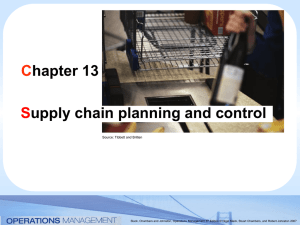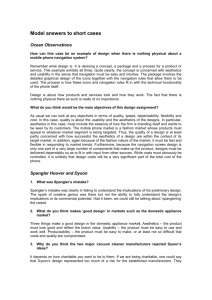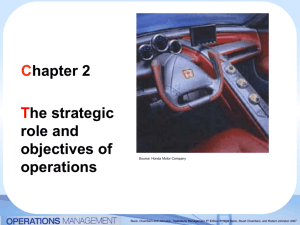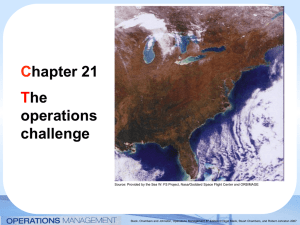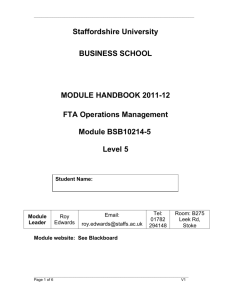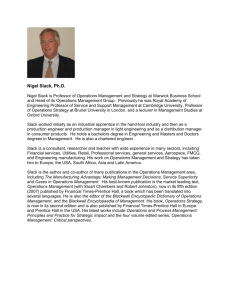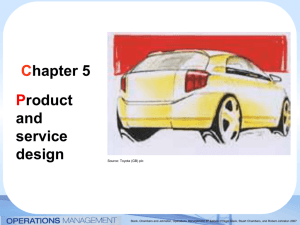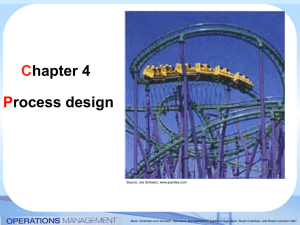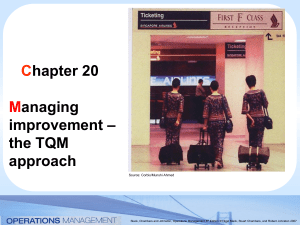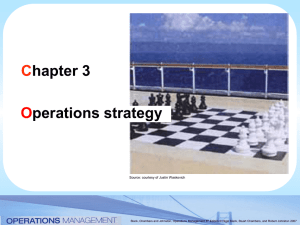Process Design
advertisement
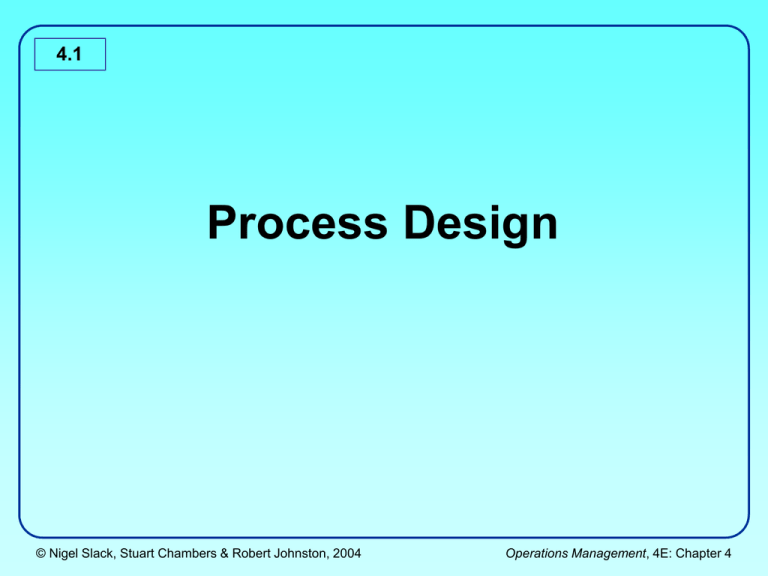
4.1 Process Design © Nigel Slack, Stuart Chambers & Robert Johnston, 2004 Operations Management, 4E: Chapter 4 4.2 Chapter Coverage • What are design and process? • Product and services design and process design are interrelated. • Design activity is a process itself • Designing processes • Process types © Nigel Slack, Stuart Chambers & Robert Johnston, 2004 Operations Management, 4E: Chapter 4 4.3 Design: “To design” refers to the process of originating and developing a plan for a product, service or process. Process: Is any part of an organization which takes a set of input resources which are then used to transform something into outputs of products or services. © Nigel Slack, Stuart Chambers & Robert Johnston, 2004 Operations Management, 4E: Chapter 4 4.4 Process Design Process design Processes that Design Products and Services Processes that Produce Products and Services Supply Network Design Concept Generation Screening Layout and Flow Preliminary Design Evaluation and Improvement Process Technology Job Design Prototyping and final design © Nigel Slack, Stuart Chambers & Robert Johnston, 2004 Operations Management, 4E: Chapter 4 4.5 Nature of the design activity: 1) Design is inevitable – products, services and the processes which produce them all have to be designed. 2) Product design influences process design – decisions taken during the design of a product or service will have an impact on the decisions taken during the design of the process which produces those products or services and vice versa. © Nigel Slack, Stuart Chambers & Robert Johnston, 2004 Operations Management, 4E: Chapter 4 4.6 Product & services design are interrelated to its process design Designing the Product or Service Products and services should be designed in such a way that they can be created effectively Designing the Processes that Produce the Product or Service Processes should be designed so they can create all products and services which the operation is likely to introduce Decisions taken during the design of the product or service will have an impact on the process that produces them and vice versa © Nigel Slack, Stuart Chambers & Robert Johnston, 2004 Operations Management, 4E: Chapter 4 4.7 Process Design and Product/Service Design are Interrelated • • • To commit to the detailed design of a product or service consideration must be given to how it is to be produced. Design of process can constrain the design of products and services. The overlap is greater in the service industry: • Service industry - it is impossible to separate service design and process design – they are the same thing. • Manufacturing industry - it is possible to separate product design and process design but it is beneficial to consider them together because the design of products has a major effect on the cost of making them. © Nigel Slack, Stuart Chambers & Robert Johnston, 2004 Operations Management, 4E: Chapter 4 4.8 Process and product/service design must satisfy customer • Products/services designer customers satisfaction criteria • Aesthetically pleasing • Reliability • Meets expectation • Inexpensive • Quality • Easy to manufacture and deliver • Speedy • Process designer customers satisfaction achieved through: • Layout • Location • Process technology • Human skills © Nigel Slack, Stuart Chambers & Robert Johnston, 2004 Operations Management, 4E: Chapter 4 4.9 The design activity is itself a process TRANSFORMED RESOURCES Technical information Market information Time information INPUTS THE DESIGN OUTPUT ACTIVITY Finished designs which are: High quality: Error-free designs which fulfil their purpose in an effective and creative way Speedily produced: Designs which have moved from concept to detailed specification in a short time Dependably delivered: Designs which are delivered when promised Test and design equipment Design and technical staff Produced flexibly: Designs which include the latest ideas to emerge during the process TRANSFORMING RESOURCES Low cost: Designs produced without consuming excessive resources © Nigel Slack, Stuart Chambers & Robert Johnston, 2004 Operations Management, 4E: Chapter 4 4.10 Relatively early in the design activity the decisions taken will commit the operation to costs which will be incurred later 100% Percentage of final product cost committed by the design Percentage of design costs incurred 0% Start of the design activity © Nigel Slack, Stuart Chambers & Robert Johnston, 2004 Finish of the design activity Operations Management, 4E: Chapter 4 4.11 Designing processes • • • • • Process mapping Process mapping symbols Improving processes Process performance Throughput, cycle time & work in process © Nigel Slack, Stuart Chambers & Robert Johnston, 2004 Operations Management, 4E: Chapter 4 4.12 Process mapping • Used to identify different types of activities. • Shows the flow of material, people or information. • Critical analysis of process maps can improve the process. © Nigel Slack, Stuart Chambers & Robert Johnston, 2004 Operations Management, 4E: Chapter 4 4.13 Process mapping symbols Operation (an activity that directly adds value) Beginning or end of process Inspection (a check of some sort) Activity Transport (a movement of some thing) Input or Output from the process Delay (a wait, e.g. for materials) Direction of flow Storage (deliberate storage, as opposed to a delay) Decision (exercising discretion) Process mapping symbols derived from “Scientific Management” © Nigel Slack, Stuart Chambers & Robert Johnston, 2004 Process mapping symbols derived from Systems Analysis Operations Management, 4E: Chapter 4 4.14 Raw Materials Assembly Stored Sandwiches Move to Outlets Stored Sandwiches Sell Take Payment Standard sandwich process Customer Request Raw Materials Assembly Take Payment Customer Request Customized sandwich old process © Nigel Slack, Stuart Chambers & Robert Johnston, 2004 Operations Management, 4E: Chapter 4 4.15 The operation of making and selling customized sandwiches Prepare Sandwich materials and customers Bread and Base filling Assemble whole sandwich Assemble as required Take payment Customers “assembled” to sandwiches The outline process of making and selling customized sandwiches Use standard “base”? No Yes Fillings Customer Request Assemble from standard “base” The detailed process of assembling customized sandwiches Stored “Bases” © Nigel Slack, Stuart Chambers & Robert Johnston, 2004 Operations Management, 4E: Chapter 4 4.16 Customized sandwich improved new process Assemble whole sandwich Assembly of “sandwich bases” Use standard “base”? Take Payment No Fillings Yes Bread and Base filling Customer Request Stored “Bases” © Nigel Slack, Stuart Chambers & Robert Johnston, 2004 Assemble from standard “base” Operations Management, 4E: Chapter 4 4.17 ‘Two handed’ process chart Left hand Wait Right hand Pick up base plate Insert into fixture Hold base plate Pick up two supports Locate back plate Pick up screws Locate screws Pick up air driver Fasten screws Wait Replace air driver Pick up centre assembly Inspect centre assembly Hold centre assembly Locate and fix Switch on timer Wait to end test Inspect Transfer grasp Wait © Nigel Slack, Stuart Chambers & Robert Johnston, 2004 Inspect Transfer grasp Put aside Operations Management, 4E: Chapter 4 4.18 Process performance • Process performance can be judge against the five key performance objective: Quality Speed Dependability Flexibility Cost © Nigel Slack, Stuart Chambers & Robert Johnston, 2004 Operations Management, 4E: Chapter 4 4.19 Throughput, work content, cycle time, and work in process • • Throughput – the time for a unit to move through the process Work content – the total amount of work required to produce a unit of output (measured in time) • Cycle time – The average time between units of output emerging form the process • Work in process (WIP) –unfinished items in a production process waiting for further processing e. g. when customers join a queue in a process they become WIP throughput = work in process x cycle time © Nigel Slack, Stuart Chambers & Robert Johnston, 2004 Operations Management, 4E: Chapter 4 4.20 Project Processes • One-off, complex, large scale, high work content “products” • Specially made, every one customized • Defined start and finish: time, quality and cost objectives • Many different skills have to be coordinated • Fixed position layout © Nigel Slack, Stuart Chambers & Robert Johnston, 2004 Operations Management, 4E: Chapter 4 4.21 Project Process © Nigel Slack, Stuart Chambers & Robert Johnston, 2004 Operations Management, 4E: Chapter 4 4.22 Jobbing Processes • Very small quantities: “one-offs”, or only a few required • Specially made. High variety, low repetition. • Skill requirements are usually very broad • Skilled jobber, or team of jobbers complete whole product • Fixed position or process layout (routing decided by jobbers) © Nigel Slack, Stuart Chambers & Robert Johnston, 2004 Operations Management, 4E: Chapter 4 4.23 Jobbing Process © Nigel Slack, Stuart Chambers & Robert Johnston, 2004 Operations Management, 4E: Chapter 4 4.24 Batch Processes • Higher volumes and lower variety than for jobbing • Standard products, repeating demand. But can make specials • Specialized, narrower skills • Set-ups (changeovers) at each stage of production • Process or cellular layout © Nigel Slack, Stuart Chambers & Robert Johnston, 2004 Operations Management, 4E: Chapter 4 4.25 Batch Process © Nigel Slack, Stuart Chambers & Robert Johnston, 2004 Operations Management, 4E: Chapter 4 4.26 Mass (Line) Processes • • • • • Higher volumes than Batch Standard, repeat products Low and/or narrow skills No set-ups, or almost instantaneous ones Cell or product layout © Nigel Slack, Stuart Chambers & Robert Johnston, 2004 Operations Management, 4E: Chapter 4 4.27 Mass Process © Nigel Slack, Stuart Chambers & Robert Johnston, 2004 Operations Management, 4E: Chapter 4 4.28 Continuous Process • Extremely high volumes and low variety: often single product • Standard, repeat products • Highly capital-intensive and automated • Few changeovers required • Difficult and expensive to start and stop the process • Product layout: usually flow along conveyors or pipes © Nigel Slack, Stuart Chambers & Robert Johnston, 2004 Operations Management, 4E: Chapter 4 4.29 Continuous Process © Nigel Slack, Stuart Chambers & Robert Johnston, 2004 Operations Management, 4E: Chapter 4 4.30 Service process types High High Manufacturing process types Project Professional service Service shop Variety Variety Jobbing Batch Mass Low Volume High © Nigel Slack, Stuart Chambers & Robert Johnston, 2004 Mass service Low Low Continuous Low Volume High Operations Management, 4E: Chapter 4
